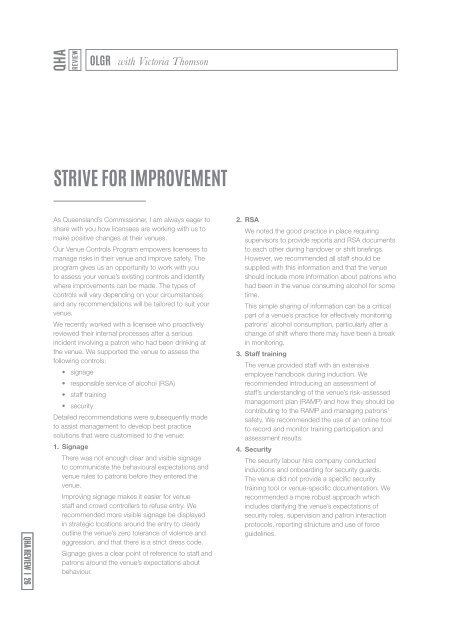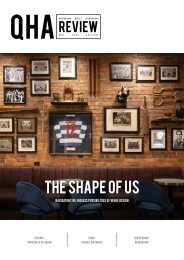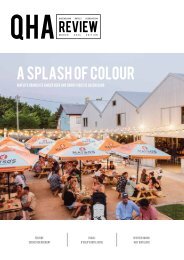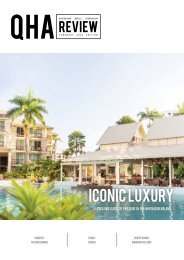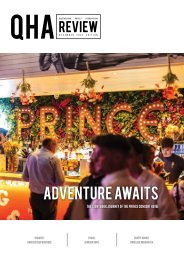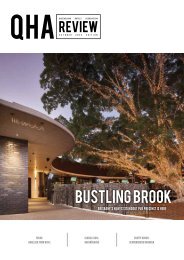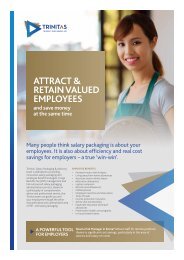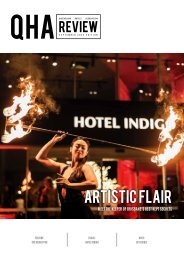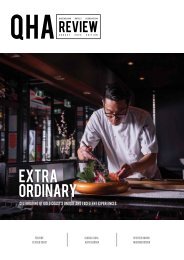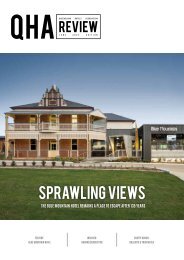QHA-Review_April_Digital
- No tags were found...
Create successful ePaper yourself
Turn your PDF publications into a flip-book with our unique Google optimized e-Paper software.
OLGR<br />
with Victoria Thomson<br />
STRIVE FOR IMPROVEMENT<br />
<strong>QHA</strong> REVIEW | 26<br />
As Queensland’s Commissioner, I am always eager to<br />
share with you how licensees are working with us to<br />
make positive changes at their venues.<br />
Our Venue Controls Program empowers licensees to<br />
manage risks in their venue and improve safety. The<br />
program gives us an opportunity to work with you<br />
to assess your venue’s existing controls and identify<br />
where improvements can be made. The types of<br />
controls will vary depending on your circumstances<br />
and any recommendations will be tailored to suit your<br />
venue.<br />
We recently worked with a licensee who proactively<br />
reviewed their internal processes after a serious<br />
incident involving a patron who had been drinking at<br />
the venue. We supported the venue to assess the<br />
following controls:<br />
• signage<br />
• responsible service of alcohol (RSA)<br />
• staff training<br />
• security<br />
Detailed recommendations were subsequently made<br />
to assist management to develop best practice<br />
solutions that were customised to the venue:<br />
1. Signage<br />
There was not enough clear and visible signage<br />
to communicate the behavioural expectations and<br />
venue rules to patrons before they entered the<br />
venue.<br />
Improving signage makes it easier for venue<br />
staff and crowd controllers to refuse entry. We<br />
recommended more visible signage be displayed<br />
in strategic locations around the entry to clearly<br />
outline the venue’s zero tolerance of violence and<br />
aggression, and that there is a strict dress code.<br />
Signage gives a clear point of reference to staff and<br />
patrons around the venue’s expectations about<br />
behaviour.<br />
2. RSA<br />
We noted the good practice in place requiring<br />
supervisors to provide reports and RSA documents<br />
to each other during handover or shift briefings.<br />
However, we recommended all staff should be<br />
supplied with this information and that the venue<br />
should include more information about patrons who<br />
had been in the venue consuming alcohol for some<br />
time.<br />
This simple sharing of information can be a critical<br />
part of a venue’s practice for effectively monitoring<br />
patrons’ alcohol consumption, particularly after a<br />
change of shift where there may have been a break<br />
in monitoring.<br />
3. Staff training<br />
The venue provided staff with an extensive<br />
employee handbook during induction. We<br />
recommended introducing an assessment of<br />
staff’s understanding of the venue’s risk-assessed<br />
management plan (RAMP) and how they should be<br />
contributing to the RAMP and managing patrons’<br />
safety. We recommended the use of an online tool<br />
to record and monitor training participation and<br />
assessment results.<br />
4. Security<br />
The security labour hire company conducted<br />
inductions and onboarding for security guards.<br />
The venue did not provide a specific security<br />
training tool or venue-specific documentation. We<br />
recommended a more robust approach which<br />
includes clarifying the venue’s expectations of<br />
security roles, supervision and patron interaction<br />
protocols, reporting structure and use of force<br />
guidelines.


